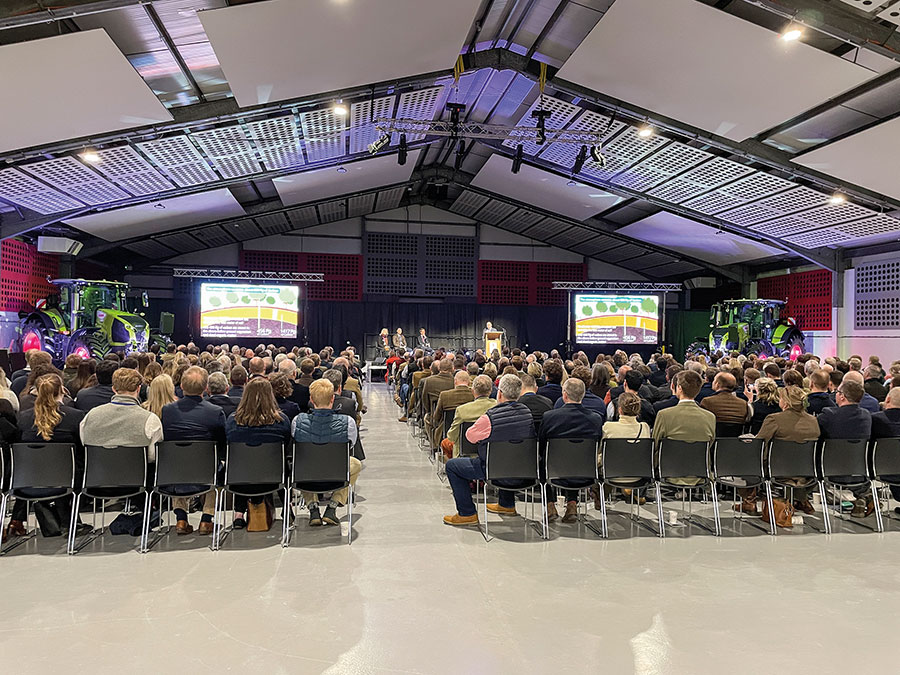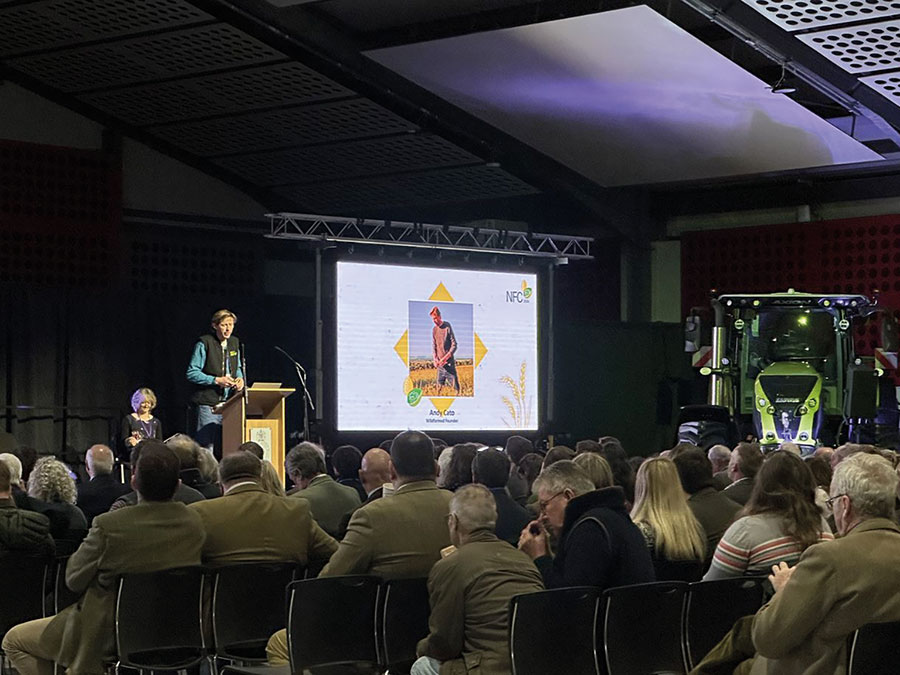Innovative solutions discussed at Norfolk Farming Conference
7th March 2024
The 2024 Norfolk Agricultural Conference attracted more than 400 delegates to its 20th anniversary event. Topics discussed included sustainable agriculture and carbon storage, and the audience heard about some of the innovative ways the industry is taking to address the many challenges the sector is facing.

Dr Belinda Clarke, who chaired the event, said: “The Norfolk Farming Conference has a tradition of hosting senior politicians, leading farmers, scientists and those who are looking to the future as our emerging leaders in the industry.
“The openness of Mark Spencer, the inspiration from the farmers, the innovation being developed by the scientists and the enthusiasm of the future leaders meant that delegates learned unique and valuable insights from different perspectives.”
Farming minister, Mark Spencer MP made the opening speech, updating delegates on actions which have been added into Land Management Schemes. These include shorter three-year agreements, and increases in payments for activities with higher beneficial environmental impact. With regard to the Sustainable Farming Incentives, he encouraged farmers who have not yet applied to do so.
Members of the audience raised concerns that the way the SFI subsidies will now work could encourage farmers to take land out of production, with consequences for British food production and security.
Regenerative approaches needs to be properly recompensed
Growers following a regenerative approach need to be properly remunerated, according to Andy Cato.
The former musician founded the regenerative farming initiative Wildfarmed, which has more than 100 farmers signed up to supply flour from wheat grown in line with the Wildfarmed Regenerative Standards.
“The soils were more suited to growing weeds than crops, but I still thought I could just continue to grow organically, so it turned out to be a triumph for the weeds.”
These include livestock integration, cover crops, companion crops, no pesticides on the growing crop and nutrition based on needs identified by sap testing.
Mr Cato said: “Society has been asking farmers to deliver yields, and they have delivered this in spectacular fashion.
“But now there are demands for something completely different, while the rest of the food system remains exactly the same. That does not seem a reasonable proposition to me, and we have to join up both ends of the food system.”
When working as a musician, he became concerned about the environmental costs of farming and food production after reading an article on the way home from a gig, which included the phrase ‘if you don’t like the system, don’t depend on it’.
He decided to do something about it – but the road to reducing the environmental footprint of food production has proved to be a tough learning curve, he said.
He started by using his garden to grow fruit and vegetables, and then sold his music publishing rights to purchase a farm in South West France. Sadly, initial results were very disappointing.
“The soils were more suited to growing weeds than crops, but I still thought I could just continue to grow organically, so it turned out to be a triumph for the weeds.”
The first few years were “grim”, he reflected, although unlike most farmers, he was able to navigate a financial precariousness by going back to playing music.
It was at this time that Albert Howard and other authors associated with the founders of the organic movement inspired him to try different approaches.
This included cover crops, herbal leys and the introduction of livestock onto the farm.
Together with his Wildfarmed co-founders, he developed a community where growers follow strategies to achieve a more regenerative farming operation and consumers can choose to buy something they believe in.
Mr Cato moved back to the UK, was awarded tenancy on a National Trust farm near Swindon, and opted for pasture cropping; some of which, but not all, worked.
He started to learn about plant diversity; for example, when growing maize, beans and squash together, they showed better stress resilience than when they were grown on their own.
Yields were also enhanced, he said, noting that these findings were corroborated by academic studies undertaken in Germany, where trials over 15 years have found a correlation between diversity and biomass.
As a result, he has adopted practices such as keeping the soil covered with diverse plants for as much time as possible – bi-cropping and poly-cropping.
But this brings other challenges, such as separating harvests because of logistical challenges, so he is working on innovative solutions.
Perceptions around regenerative farming need to change, diverse farmed landscapes are currently undervalued, and payment for having biodiversity on farm is insufficient, said Mr Cato.
“Consumers want clarity; and if you are asking someone to pay a little bit more for something, you have to tell them why. So we have come up with third-party audited protocols for regenerative arable farmers.”
At the other end of the supply chain, artisan bakeries have been recruited to supply bread baked using Wildfarmed flour. Some bigger companies have also signed up, including M&S, ASK Italian and Franco Manca, and plans are in place to recruit more.
“It is up to us to create field-to-plate networks through which customers can choose to support farmers who are growing with a regenerative landscape.”
Not all soil carbon is equal
The rhetoric is about carbon dioxide in the atmosphere, CO2 and greenhouse gas emissions, and until recently, less attention has been paid to opportunities to build carbon within the soil, said University of East Anglia professor of oil science, Brian Reid.
Prof Reid explained that not all carbon in the soil is the same; broadly speaking, there are two types of carbon – labile, and recalcitrant.
Labile carbon is more easily utilised in the soil, and provides a food source for soil microbes and soil fauna. This labile carbon is the base of the soil food web and underpins soil health. Recalcitrant carbon is more difficult to break down, and therefore offers the opportunity for longer-term carbon capture.
Prof Reid said: “As more people start to trade carbon, the question is whether they will they opt to trade only the higher integrity recalcitrant carbon that offers longer-term carbon storage permanence.”

Carbon-rich materials, such as compost, anaerobic digestate, paper crumble and biochar have the potential to increase soil carbon. But these materials have different labile and recalcitrant carbon loads. By understanding their carbon stability profile, their use as soil conditioners can be tailored to deliver desired soil health and carbon storage outcomes.
He highlighted projects being undertaken by the University of East Anglia exploring different carbon rich soil amendment to recarbonise soil. These projects are considering how carbon stability profiles are linked to microbial and mesofauna profiles.
Nonetheless, amendment-driven soil recarbonisation may take decades to realise significant gains in soil carbon stocks, but these approaches are a valuable complement to other sustainable soil management practices.
Another project he is involved with is looking at conversion from conventional arable to regenerative soft fruit production.
“This research has evidenced meaningful gains in soil carbon stocks over a seven-year transitional period, and an increase in water stable aggregates that offer protection for both labile and recalcitrant carbon.”
Close ties with the Netherlands
Philip de Jong, the Dutch agricultural attaché spoke about the historical ties between the Netherlands and Norfolk going back to the 17th century.
“We have common issues such as land and water management and also research,” he said, noting long-standing collaboration between Wageningen and the John Innes Centre.
“According to David Attenborough, Dutch farmers have become experts in getting the most from every hectare of agricultural land, and increasingly they are doing so sustainably.
“It is this expertise to produce more with less, is why the Netherlands is seen as world-leading for feeding the next generation.”
However, the Dutch success story has come at an environmental cost; the Dutch have not succeeded in sufficiently reconciling productivity and sustainability, he admitted.
“In the short-term, our focus will be on solving the nitrogen emissions with measures such as a buy-out scheme, reallocation of farms and reducing the intensity of production, and applying innovative solutions.”
The Dutch government has proposed a regional-based approach with solutions drafted by each of the provinces from a consortium of representatives of government bodies, civil society engineers, businesses, farmers and nature organisations and water management boards.
“These regional plans should guarantee that food production, nature and the environment, and water quality will all be tackled in a coherent, integrated way on a regional level adapted to local conditions.”
Finances to realise these plans will have to come from the national budget, he noted.
“The first plans have been submitted by the national provinces, and the big question was, what does it mean for farmers and their future.”
As a result, the minister decided to develop an initiative to bring stakeholders in the production chain together to offer farmers a long-term perspective to develop their businesses.
However, he reported, last August all intents to reach such an agreement, failed when the biggest farmer organisation left the talks.
“There was not enough trust in the offered solutions. Shortly afterwards, the Dutch government resigned and a new government has to take the decisions.”
Other steps are also being made, for instance the Farm of the Future is a Dutch initiative has the goal of developing a collaborative platform not only for the different regions but also a network of international farms.
“International cooperation provides opportunities to collaborate and benefit from each other’s innovations.”
Read more rural news


